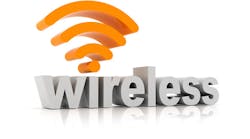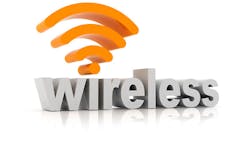UWB is a curious wireless technology in that it uses a huge swath of spectrum to transmit digital data. We all know that the faster the bit stream the more bandwidth it takes to accommodate it. But UWB takes much more. That is usually a bad thing given the ever increasing shortage of good useful spectrum. However, modern UWB is restricted to ultralow power so there is little chance that it will interfere with others in the same spectrum. In 2002, the FCC approved of UWB in the 3.1 to 10.6 GHz range at a power level of -41.3 dBm/MHz or 75 nW. At that power level, UWB looks like noise to narrowband wireless radios in the same region.
The basic definition of UWB is that it must occupy at least 500 MHz of spectrum or 20% or more of its center frequency. Early UWB systems used short Gaussian pulses to achieve that goal. While such pulsed methods are still used in UWB radar, other applications use the OFDM version of UWB conceived and promoted by the WiMedia Alliance. This standard divides the allowed spectrum into 528 MHz sub-bands of OFDM channels. The standard supports data rates to 480 Mb/s at a range up to 10 meters. Attempts by the IEEE to standardize UWB failed so most semiconductor vendors went with the WiMedia specifications. Multiple companies fielded chips.
UWB was not widely adopted, but it did show up in a few laptops and docking stations for video monitor connectivity. It was also used in several cameras and dongles and other devices for consumer HD video connections. Then faster versions of Wi-Fi (802.11n/ac/ad) came along and virtually wiped out the UWB business. The newer 5 GHz 11ac and the 60 GHz 11ad versions offer 1 Gb/s+ rates over longer ranges making UWB a has-been.
However, UWB has some redeeming qualities that make it desirable in some applications. Besides its high data rate potential UWB offers some advantages over other wireless techniques. These include greater resistance to noise, superior security, high jamming resistance, greater multipath immunity, low power consumption, and high penetration ability. Such qualities are a great fit for military applications.
The last-standing UWB company, Alereon of Austin, TX recently hooked up with BAE Systems and DRS Technologies to develop and supply new night-vision weapon sights and head-mounted goggles. I spoke with David Nix the VP of Engineering at Alereon who said that the company supplies both vendors with UWB radios that connect the weapon sight and goggles via a high-speed, difficult-to detect link that carries real-time video and sensor data. This arrangement lets soldiers operate more efficiently with greater effectiveness and survivability. By eliminating the wires between the weapon and the goggles, the weight is reduces and snag hazards are avoided. No doubt the military will find other uses for UWB.
UWB is also a good fit for medical devices since Wi-Fi cable replacement in hospitals is a no-no to avoid interference with critical Wi-Fi networks. UWB now competes with 802.11ad but this 60 GHz technology is still very power hungry and very line of sight (LOS) restricted. Any place low power and non-LOS is critical, UWB is a good option.
It was great to hear Alereon survived and it did so by perseverance and innovation in finding new uses for the technology. Maybe some new applications are yet to be found. UWB is still an option to consider next time you are trying to identify a technology for a new application. If you were a wireless company CEO, what would you do with it?
If you want a good refresher on UWB, check out the new book Ultrawideband Antennas for Microwave Imaging Systems by Tayeb A. Denidni and Gijo Augustin recently published by Artech House. While it focuses on antennas for UWB imaging systems, the book has great sections reviewing the basics of antennas and electromagnetic waves as well as summarizing the latest state of UWB technology. A good addition to your wireless library.
To see what I had to say about UWB back in 2010, check out "Whatever Happened to UWB?" on Electronic Design.

